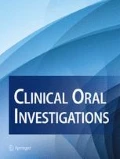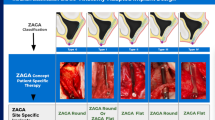Abstract
Objectives
This study presents a retrospective study aimed to analyze the facial features at each stage of surgical-orthodontic treatment for skeletal class III malocclusion, and predict the changes in the lips after treatment.
Materials and methods
There were 49 skeletal class III malocclusion patients treated with bimaxillary surgery and orthodontic treatment enrolled in this study. Lateral cephalograms were obtained before treatment (T0), 1 month before surgery (T1), 1 month after surgery (T2), and after debonding (T3) for cephalometric measurements. After the measurement of the required variables, paired t-test, Pearson’s correlation analysis, and multiple linear regression were performed using SPSS 19.0.
Results
The main factors associated with changes in the upper lip included ΔUIE-V, ΔA-V, ΔU1A-V, and ΔL1A-V, and those associated with changes in the lower lip included ΔLIE-V, ΔL1A-V, ΔB-V, ΔPog-V, and Δfacial angle. The predicted regression equation for the horizontal change in the upper lip was represented as ΔUL-vertical reference line (VRL) = 9.430 + 0.779 (ΔUIE-VRL) − 0.542(VULT) (P < 0.05) with a mean error of 1.04 mm; the corresponding equation for the lower lip was ΔLL-VRL = −1.670 + 0.530 (ΔB-VRL) + 0.360 (Ls-E) + 0.393 (ΔLIE-VRL) (P < 0.05), with a mean error of 1.51 mm.
Conclusions
This study explored the relationship between orthognathic surgery and changes in the lips and obtained the predictive equations of lip position after treatment by using multiple linear regression, which likely offers a reference for prediction of soft tissue changes before surgical-orthodontic treatment in patients with skeletal class III malocclusion.
Clinical relevance
The findings can help dentists to rapidly predict the lip changes after surgical-orthodontic treatment in patients with skeletal class III malocclusion. The study has been registered with the Chinese Clinical Trial Registration (No: ChiCTR1800017694).





Similar content being viewed by others
Abbreviations
- CBCT:
-
cone beam computed tomography
- HRL:
-
the horizontal reference line
- ICC:
-
intra-group correlation coefficient
- Li:
-
labrale inferius
- LIA:
-
the root apex of the lower central incisor
- LIE:
-
the incisal edge of the lower central incisor
- LL:
-
lower lip
- Prn:
-
pronasale
- SPSS:
-
Statistical Product and Service Solutions
- UIA:
-
the root apex of the upper central incisor
- UIE:
-
the incisal edge of the upper central incisor
- UL:
-
upper lip
- VRL:
-
the vertical reference line
References
Ngan P, Moon W (2015) Evolution of Class III treatment in orthodontics. Am J Orthod Dentofac Orthop 148(1):22–36. https://doi.org/10.1016/j.ajodo.2015.04.012
Chew MT (2005) Soft and hard tissue changes after bimaxillary surgery in Chinese Class III patients. Angle Orthod 75(6):959–963. https://doi.org/10.1043/0003-3219(2005)75[959:SAHTCA]2.0.CO;2
Kiyak HA, Zeitler DL (1988) Self-assessment of profile and body image among orthognathic surgery patients before and two years after surgery. J Oral Maxillofac Surg 46(5):365–371
Proffit WR, Jackson TH, Turvey TA (2013) Changes in the pattern of patients receiving surgical-orthodontic treatment. Am J Orthod Dentofac Orthop 143(6):793–798. https://doi.org/10.1016/j.ajodo.2013.01.014
Verdenik M, Ihan HN (2014) Differences in three-dimensional soft tissue changes after upper, lower, or both jaw orthognathic surgery in skeletal class III patients. Int J Oral Maxillofac Surg 43(11):1345–1351. https://doi.org/10.1016/j.ijom.2014.06.017
Koh CH, Chew MT (2004) Predictability of soft tissue profile changes following bimaxillary surgery in skeletal class III Chinese patients. J Oral Maxillofac Surg 62(12):1505–1509
Jones RM, Khambay BS, McHugh S, Ayoub AF (2007) The validity of a computer-assisted simulation system for orthognathic surgery (CASSOS) for planning the surgical correction of class III skeletal deformities: single-jaw versus bimaxillary surgery. Int J Oral Maxillofac Surg 36(10):900–908. https://doi.org/10.1016/j.ijom.2007.05.015
Park JY, Kim MJ, Hwang SJ (2013) Soft tissue profile changes after setback genioplasty in orthognathic surgery patients. J Craniomaxillofac Surg 41(7):657–664. https://doi.org/10.1016/j.jcms.2013.01.005
Marsan G, Oztas E, Kuvat SV, Cura N, Emekli U (2009) Changes in soft tissue profile after mandibular setback surgery in Class III subjects. Int J Oral Maxillofac Surg 38(3):236–240. https://doi.org/10.1016/j.ijom.2008.12.005
Jeon HM, Choi JY, Baek SH (2014) Soft tissue changes after posterior impaction and setback of the maxilla with Le Fort I osteotomy in skeletal class III patients. J Craniofac Surg 25(4):1495–1500. https://doi.org/10.1097/SCS.0000000000001005
Rupperti S, Winterhalder P, Rudzki I, Mast G, Holberg C (2018) Changes in the facial soft-tissue profile after mandibular orthognathic surgery. Clin Oral Investig 23:1771–1776. https://doi.org/10.1007/s00784-018-2609-5
Park SB, Yoon JK, Kim YI, Hwang DS, Cho BH, Son WS (2012) The evaluation of the nasal morphologic changes after bimaxillary surgery in skeletal class III maloccusion by using the superimposition of cone-beam computed tomography (CBCT) volumes. J Craniomaxillofac Surg 40(4):e87–e92. https://doi.org/10.1016/j.jcms.2011.05.008
Ghassemi M, Ghassemi A, Showkatbakhsh R, Ahmad SS, Shadab M, Modabber A, Jamilian A (2014) Evaluation of soft and hard tissue changes after bimaxillary surgery in class III orthognathic surgery and aesthetic consideration. Natl J Maxillofac Surg 5(2):157–160. https://doi.org/10.4103/0975-5950.154819
Fish LC, Epker BN (1987) Dentofacial deformities related to midface deficiencies. Integrated orthodontic-surgical correction. J Clin Orthod 21(9):654–664
Marsan G, Hocaoglu E, Cura N, Emekli U (2015) Nasal profile changes with le fort I maxillary advancement surgery. Cleft Palate Craniofac J 52(2):152–156. https://doi.org/10.1597/13-150
Elnagar MH, Aronovich S, Kusnoto B (2020) Digital workflow for combined orthodontics and orthognathic surgery. Oral Maxillofac Surg Clin North Am 32(1):1–14. https://doi.org/10.1016/j.coms.2019.08.004
Farronato G, Galbiati G, Esposito L, Mortellaro C, Zanoni F, Maspero C (2018) Three-dimensional virtual treatment planning: presurgical evaluation. J Craniofac Surg 29(5):e433–e437. https://doi.org/10.1097/SCS.0000000000004455
Elshebiny T, Morcos S, Mohammad A, Quereshy F, Valiathan M (2019) Accuracy of three-dimensional soft tissue prediction in orthognathic cases using Dolphin three-dimensional software. J Craniofac Surg 30(2):525–528. https://doi.org/10.1097/SCS.0000000000005037
Bell RB (2018) A history of orthognathic surgery in North America. J Oral Maxillofac Surg 76(12):2466–2481. https://doi.org/10.1016/j.joms.2018.09.006
Xue C, Tian Y, Wang L, Yang X, Luo E, Bai D (2018) Surgical guide and CAD/CAM prebent titanium plate for sagittal split ramus osteotomy in the correction of mandibular prognathism. Br J Oral Maxillofac Surg 56(7):586–593. https://doi.org/10.1016/j.bjoms.2018.06.007
Politi M, Costa F, Cian R, Polini F, Robiony M (2004) Stability of skeletal class III malocclusion after combined maxillary and mandibular procedures: rigid internal fixation versus wire osteosynthesis of the mandible. J Oral Maxillofac Surg 62(2):169–181. https://doi.org/10.1016/j.joms.2003.04.010
Rocha VA, Neto AI, Rebello IM, de Souza GM, Esteves LS, dos Santos JN, Zanetta-Barbosa D, do Prado CJ (2015) Skeletal stability in orthognathic surgery: evaluation of methods of rigid internal fixation after counterclockwise rotation in patients with class II deformities. Br J Oral Maxillofac Surg 53(8):730–735. https://doi.org/10.1016/j.bjoms.2015.05.002
Pektas ZO, Kircelli BH, Cilasun U, Uckan S (2007) The accuracy of computer-assisted surgical planning in soft tissue prediction following orthognathic surgery. Int J Med Robot 3:64–71. https://doi.org/10.1002/rcs.127
Nadjmi N, Tehranchi A, Azami N, Saedi B, Mollemans W (2013) Comparison of soft-tissue profiles in Le Fort I osteotomy patients with Dolphin and Maxilim softwares. Am J Orthod Dentofac Orthop 144(5):654–662. https://doi.org/10.1016/j.ajodo.2013.06.019
Kaipatur NR, Flores-Mir C (2009) Accuracy of computer programs in predicting orthognathic surgery soft tissue response. J Oral Maxillofac Surg 67(4):751–759. https://doi.org/10.1016/j.joms.2008.11.006
Song GY, Li G, Lu WH, Han B, Xu TM (2019) Distortion and magnification of four digital cephalometric units. Niger J Clin Pract 22(12):1644–1653. https://doi.org/10.4103/njcp.njcp_184_19
Dibbets JM, Nolte K (2002) Effect of magnification on lateral cephalometric studies. Am J Orthod Dentofac Orthop 122(2):196–201
Cohen JM (2005) Comparing digital and conventional cephalometric radiographs. Am J Orthod Dentofac Orthop 128(2):157–160. https://doi.org/10.1016/j.ajodo.2005.03.017
Chadwick JW, Prentice RN, Major PW, Lam EW (2009) Image distortion and magnification of 3 digital CCD cephalometric systems. Oral Surg Oral Med Oral Pathol Oral Radiol Endod 107(1):105–112. https://doi.org/10.1016/j.tripleo.2008.09.025
Mankad B, Cisneros GJ, Freeman K, Eisig SB (1999) Prediction accuracy of soft tissue profile in orthognathic surgery. Int J Adult Orthodon Orthognath Surg 14(1):19–26
Enacar A, Taner T, Toroglu S (1999) Analysis of soft tissue profile changes associated with mandibular setback and double-jaw surgeries. Int J Adult Orthodon Orthognath Surg 14(1):27–35
Bengtsson M, Wall G, Greiff L, Rasmusson L (2017) Treatment outcome in orthognathic surgery-a prospective randomized blinded case-controlled comparison of planning accuracy in computer-assisted two- and three-dimensional planning techniques (part II). J Craniomaxillofac Surg 45(9):1419–1424. https://doi.org/10.1016/j.jcms.2017.07.001
Rustemeyer J, Martin A (2013) Soft tissue response in orthognathic surgery patients treated by bimaxillary osteotomy: cephalometry compared with 2-D photogrammetry. Oral Maxillofac Surg 17(1):33–41. https://doi.org/10.1007/s10006-012-0330-0
Georgalis K, Woods MG (2015) A study of Class III treatment: orthodontic camouflage vs orthognathic surgery. Aust Orthod J 31(2):138–148
Johnston C, Burden D, Kennedy D, Harradine N, Stevenson M (2006) Class III surgical-orthodontic treatment: a cephalometric study. Am J Orthod Dentofac Orthop 130(3):300–309. https://doi.org/10.1016/j.ajodo.2005.01.023
Troy BA, Shanker S, Fields HW, Vig K, Johnston W (2009) Comparison of incisor inclination in patients with Class III malocclusion treated with orthognathic surgery or orthodontic camouflage. Am J Orthod Dentofac Orthop 135(2):146 e141–146 e149; discussion 146-147. https://doi.org/10.1016/j.ajodo.2008.07.012
Mcneil C, Mcintyre GT, Laverick S (2014) How much incisor decompensation is achieved prior to orthognathic surgery? J Clin Exp Dent 6(3):e225
Becker OE, Avelar RL, Dolzan Ado N, Haas OL Jr, Scolari N, Oliveira RB (2014) Soft and hard tissue changes in skeletal Class III patients treated with double-jaw orthognathic surgery-maxillary advancement and mandibular setback. Int J Oral Maxillofac Surg 43(2):204–212. https://doi.org/10.1016/j.ijom.2013.06.006
Freihofer HP Jr (1976) The lip profile after correction of retromaxillism in cleft and non-cleft patients. J Maxillofac Surg 4(3):136–141
Jokic D, Jokic D, Uglesic V, Macan D, Knezevic P (2013) Soft tissue changes after mandibular setback and bimaxillary surgery in Class III patients. Angle Orthod 83(5):817–823. https://doi.org/10.2319/100112-775.1
Hemmatpour S, Kadkhodaei Oliadarani F, Hasani A, Rakhshan V (2016) Frontal-view nasolabial soft tissue alterations after bimaxillary orthognathic surgery in Class III patients. J Orofac Orthop 77(6):400–408. https://doi.org/10.1007/s00056-016-0047-z
Marsan G, Cura N, Emekli U (2009) Soft and hard tissue changes after bimaxillary surgery in Turkish female Class III patients. J Craniomaxillofac Surg 37(1):8–17. https://doi.org/10.1016/j.jcms.2008.07.004
Raschke GF, Rieger UM, Peisker A, Djedovic G, Gomez-Dammeier M, Guentsch A, Schaefer O, Schultze-Mosgau S (2015) Morphologic outcome of bimaxillary surgery--an anthropometric appraisal. Med Oral Patol Oral Cir Bucal 20(1):e103–e110
Choi JW, Lee JY, Oh TS, Kwon SM, Yang SJ, Koh KS (2014) Frontal soft tissue analysis using a 3 dimensional camera following two-jaw rotational orthognathic surgery in skeletal class III patients. J Craniomaxillofac Surg 42(3):220–226
Suh HY, Lee SJ, Lee YS, Donatelli RE, Wheeler TT, Kim SH, Eo SH, Seo BM (2012) A more accurate method of predicting soft tissue changes after mandibular setback surgery. J Oral Maxillofac Surg 70(10):e553–e562. https://doi.org/10.1016/j.joms.2012.06.187
Lee YS, Suh HY, Lee SJ, Donatelli RE (2014) A more accurate soft-tissue prediction model for Class III 2-jaw surgeries. Am J Orthod Dentofac Orthop 146(6):724–733. https://doi.org/10.1016/j.ajodo.2014.08.010
Funding
This work was supported by grants from the National Natural Science Foundation of China (51672009), Beijing Municipal Natural Science Foundation (7172241), National Natural Science Founds for Outstanding Young Scholars of China (81922019), and National Youth Top-notch Talent Support Program (QNBJ2019-3).
Author information
Authors and Affiliations
Corresponding authors
Ethics declarations
Ethics approval
This article does not contain any studies with human participants or animals performed by any of the authors.
Informed consent
For this type of study, formal consent is not required.
Conflict of interest
The authors declare no competing interests.
Additional information
Publisher’s note
Springer Nature remains neutral with regard to jurisdictional claims in published maps and institutional affiliations.
Supplementary Information
ESM 1
(DOCX 14 kb).
Rights and permissions
About this article
Cite this article
Lu, W., Song, G., Sun, Q. et al. Analysis of facial features and prediction of lip position in skeletal class III malocclusion adult patients undergoing surgical-orthodontic treatment. Clin Oral Invest 25, 5227–5238 (2021). https://doi.org/10.1007/s00784-021-03830-x
Received:
Accepted:
Published:
Issue Date:
DOI: https://doi.org/10.1007/s00784-021-03830-x



